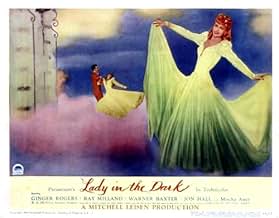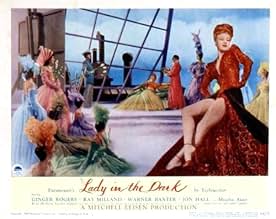NOTE IMDb
5,9/10
610
MA NOTE
Ajouter une intrigue dans votre langueLiza Elliott, "Allure" magazines editor-in-chief, suffers from headaches and continuous daydreams and undergoes psychoanalysis to determine why.Liza Elliott, "Allure" magazines editor-in-chief, suffers from headaches and continuous daydreams and undergoes psychoanalysis to determine why.Liza Elliott, "Allure" magazines editor-in-chief, suffers from headaches and continuous daydreams and undergoes psychoanalysis to determine why.
- Réalisation
- Scénario
- Casting principal
- Nommé pour 3 Oscars
- 1 victoire et 3 nominations au total
Avis à la une
Liza (Ginger Rogers) is the editor of a magazine who can no longer make decisions. She suffers headaches because she is highly strung about work and she has a love life that she is not comfortable with. Through psychoanalysis with Dr Brooks (Barry Sullivan), she unravels her troubles by recounting 3 dream sequences. Can she regain her decisiveness?
This film is a bit girly in that it concerns one woman's journey to discover lost memories and understand her behaviours. It has great colour, good costumes and it's well acted with a spattering of humour throughout. The bulk of the film comes in the form of dream sequences which are musical, colourful and surreal. The 2nd sequence has a pointless dance scene which drags on a bit but overall the dreams are entertaining. The rest of the film follows the romances that Liza has alongside her role as a tough "boss lady". The film is fun and has a happy ending.
This film is a bit girly in that it concerns one woman's journey to discover lost memories and understand her behaviours. It has great colour, good costumes and it's well acted with a spattering of humour throughout. The bulk of the film comes in the form of dream sequences which are musical, colourful and surreal. The 2nd sequence has a pointless dance scene which drags on a bit but overall the dreams are entertaining. The rest of the film follows the romances that Liza has alongside her role as a tough "boss lady". The film is fun and has a happy ending.
"Lady in the Dark" from 1944 is an adaptation of the Broadway musical of the same name, which starred Gertrude Lawrence and made a star out of Danny Kaye. Mischa Auer, Jon Hall, Ray Milland, and Gail Russell. Auer is in Kaye's role, and his show-stopping number, "Tchaikovsky" was cut.
Actually, the music in this version is incidental to the film. Ginger Rogers plays Liza, the editor of a fashion magazine. She sees a doctor because of headaches and inability to concentrate. He sends her to a psychiatrist (Barry Sullivan).
Psychology and psychiatry really hit their stride during World War II for obvious reasons. Though "Lady in the Dark" is dated in its views toward women, the unraveling of Liza's psyche through musical dreams is very entertaining.
Ginger Rogers is spectacular - a beautiful actress and dancer, she radiates light in her gorgeous gowns, which belie her normal non-dream office attire. She gives a touching performance of a conflicted, unhappy woman who can't embrace life but doesn't understand why.
Ray Milland is charming and funny as Charley, Liza's office nemesis, and Mischa Auer as the temperamental photographer is excellent. Jon Hall and Warner Baxter are very good, but their characters don't have the development of the other roles.
Probably the 1954 Lady in the Dark starring Ann Sothern is better and truer to the show. This Lady is worth seeing for Ginger.
Actually, the music in this version is incidental to the film. Ginger Rogers plays Liza, the editor of a fashion magazine. She sees a doctor because of headaches and inability to concentrate. He sends her to a psychiatrist (Barry Sullivan).
Psychology and psychiatry really hit their stride during World War II for obvious reasons. Though "Lady in the Dark" is dated in its views toward women, the unraveling of Liza's psyche through musical dreams is very entertaining.
Ginger Rogers is spectacular - a beautiful actress and dancer, she radiates light in her gorgeous gowns, which belie her normal non-dream office attire. She gives a touching performance of a conflicted, unhappy woman who can't embrace life but doesn't understand why.
Ray Milland is charming and funny as Charley, Liza's office nemesis, and Mischa Auer as the temperamental photographer is excellent. Jon Hall and Warner Baxter are very good, but their characters don't have the development of the other roles.
Probably the 1954 Lady in the Dark starring Ann Sothern is better and truer to the show. This Lady is worth seeing for Ginger.
I won't criticize much because I really like everything that Ginger Rogers does, yet somehow I get the feeling about this film, "there should have been more." At least I think more could have been done with the story.
Also, it brings to mind her later film, "It had to be You" which is a similar, comedic journey into the subconscious layers of the mind, obviously a popular topic of the day.
Ray Milland is in fine form here and I consider it one of his best roles.
The scenes are beautifully presented, very stagey at times with actors seemingly going through the motions, but the artistry of the settings and gowns is impeccable. All in all it's meant as light entertainment and ought to be viewed in that manner. Wish the video was available too.
Also, it brings to mind her later film, "It had to be You" which is a similar, comedic journey into the subconscious layers of the mind, obviously a popular topic of the day.
Ray Milland is in fine form here and I consider it one of his best roles.
The scenes are beautifully presented, very stagey at times with actors seemingly going through the motions, but the artistry of the settings and gowns is impeccable. All in all it's meant as light entertainment and ought to be viewed in that manner. Wish the video was available too.
A Technicolor spectacular, with costumes and wonderful sets to match, but the story isn't much, mostly what you might expect to read in Popular Psychoanalysis magazine.
Best are the dream and reverie sequences, especially the trial in the circus ring. These are where the singing and dancing is, but there is not much and what little there is is not very exciting.
Best are the dream and reverie sequences, especially the trial in the circus ring. These are where the singing and dancing is, but there is not much and what little there is is not very exciting.
"Lady in the Dark" is a curiosity. The circus sequence with "The Saga of Jenny" gives a taste of what the movie version of the Broadway show might have been like (as other commentators have noted, the song is the sole survivor of the Broadway score by Weill and Gershwin, aside from snatches of "My Ship" and "Suddenly it's Spring", and a verse from "Once Life to Life" which Ginger Rogers recites). Ginger is a knockout, even in her "plain" business suits. The visual design is so rich you could swim in it- it was lovely to see the 40s magazine design as well as the sets. And the costumes! The sequin lined mink skirt is stunning, and so is the gown in the wedding sequence. The psychoanalysis storyline is well handled for a movie made in this period when analysis was strange and frightening to the audience. However, what could have been an exquisite soufflé is let down by the bizarre decision to cut all but one of the numbers and the development of the plot. It suggests that women are miserable in business suits and are far happier wearing frou frou gowns and being "dominated" by men (its terminology, not mine). I will say in the plot's defense (if I may take Ray Milland's part in the circus sequence for a moment) that it doesn't have Ginger pairing off with irresistible but insecure movie star Randy Curtis. When she announced that she was going to marry him and give up her job I yelled out, "You'll be sorry!" The writers recognize that Randy and staying home to be a housewife (even a Hollywood one) would bore Ginger's character out of her tree. Her sparring colleague is a far better choice, and there's a hint in the final that perhaps neither Ray or Ginger will dominate the other, but be partners in running the magazine (they're both overwhelmed with enthusiasm for it). But this hint of equality isn't enough to redeem Ray's earlier nastiness to Ginger, or the tone of misogyny. The movie still comes down with a thud, like Ginger at the end when Ray takes her chair.
Le saviez-vous
- AnecdotesThis was one of the first films to use the word "sex." Ray Milland says, "Rage is a pretty good substitute for sex, isn't it?"
- Citations
Russell Paxton: "This is the end! The absolute end!"
- Crédits fousAt the start of the film the Paramount logo is set at night, in the dark.
At the end of the film the Paramount logo is seen at dawn, come into the light.
- ConnexionsReferenced in Book Revue (1946)
- Bandes originalesMain Title
Music by James Jimmy Van Heusen and Lyrics by Johnny Burke
Performed by the Paramount Studio Orchestra and Chorus
Meilleurs choix
Connectez-vous pour évaluer et suivre la liste de favoris afin de recevoir des recommandations personnalisées
- How long is Lady in the Dark?Alimenté par Alexa
Détails
- Date de sortie
- Pays d’origine
- Langue
- Aussi connu sous le nom de
- Lady in the Dark
- Lieux de tournage
- Société de production
- Voir plus de crédits d'entreprise sur IMDbPro
- Durée1 heure 40 minutes
- Rapport de forme
- 1.37 : 1
Contribuer à cette page
Suggérer une modification ou ajouter du contenu manquant

Lacune principale
By what name was Les nuits ensorcelées (1944) officially released in India in English?
Répondre


































